CiM Tester Feedback
-
Thai Orchid is a unique addition to the 104 lampworking palette.
“It is a nice addition to the purple color palette in our industry. It’s dark enough not to be brown and purple enough not to be red. It’s PURPLE. A beautiful and very welcome addition to the purples that are already out there.” – Sue Stewart
“A luscious orchid! Nothing in the Moretti palette to compare.” – Leslie Anne Bitgood
“A true opaque purple, without the problems that come with so many.” – Elise Swope
“It doesn't have a brown undertone! Yay! I made one bead with both colors...and you could really see the brown colors in the moretti purples, and not in the Thai Orchid.” – Evil Glass
“It’s close to other 104 violets, but more intense, more purple. Better.” – Terri Budrow-Nelson
-
Thai Orchid is very dark.
“It’s hard to photograph! This color and Lapis are so dark they appear almost black in photos.” – Gail Witt
“This one just stays purple. It is maybe on the dark side but it stays true to the rod color. It definitely is a WYSIWYG color as seems to be the case with the entire CiM line.” – Sue Stewart
-
Some testers reported a metallic sheen when reducing Thai Orchid.
"I noticed a metallic sheen when working too close to the torch head or when in a reduction flame.” – Tina Lamasney
“I reduced it several times and didn’t see any change.” – Gail Witt
“I fried, reduced, cooled, reduced and got no reaction.” – Leslie Anne Bitgood
“I didn’t reduce much, but Vonna did. Thai Orchid began to acquire a silvered look in a reduction flame. Most of the silver look burned back off when I changed to a neutral or slight oxidizing flame.” – Bonnie Polinski
“It gets silver when worked for a long period of time.” – Genea Crivello
“I noticed a metallic sheen when working, but it wasn't there when not hot.” – Evil Glass
-
We asked our testers to compare Grape Ape, Evil Queen, Poi, & Thai Orchid.
"I had a tough time with all of these purples because they all looked the same to me. Poi is lighter in color, but it is relatively close to Effetre violet, so then you have the price thing to consider. Evil Queen isn't a bad purple, but my complaint about it is just that it is too dark. Grape Ape striated a lot." – Bethany Lemasters
"All these purples look fairly similar when made into spacers. But I like Evil Queen because it is a slightly brighter purple. It’s a toss-up between Poi and Thai Orchid because they both got great reactions when used over Hades, so I think they can do some neat effects." – Lori Bergmann
"Poi is my favorite." – Sue Stewart
"Evil Queen is the best of the bunch even though it is expensive. Poi is my favorite when encased due to lines of deeper purple that develop. Thai Orchid is my favorite for pulling out a deep silver luster." – Starleen Colon
"For me, I find Grape Ape, Poi and Thai Orchid to be very similar in hue, but with different densities. They definitely have their place in the current palette of purples, but they are very similar. Evil Queen is a very nice medium purple and would get my vote for my favorite of the four. I think Evil Queen is a better neutral medium purple than the Italian colors." – Renee Wiggins
"Grape Ape sometimes has a dirty look to it. Evil Queen can work for flowers if put over Peace. Poi is kinda washed out looking. Thai Orchid is my favorite, dark and opaque." – Pat O'Brien
"Evil Queen seems too close to Moretti in a shade that is less interesting to me. I like Thai Orchid the best. It’s a very rich, pure and dark purple that doesn’t seem to have any gray or other colors in it." – Marcy Lamberson
"If I have to choose, I guess Grape Ape is my favorite because it seems to be the darkest." – Maija-Leena Autio
"Evil Queen is hands-down my fav, but it costs quite a bit more, so I generally try to make use of one of the lower priced purples, usually Grape Ape." – Kathy Coon
"I love Grape Ape because it really is a grapey purple opaque. This color fills a hole in the glass palette. I definitely like Evil Queen the best as it is the most opaque. Poi has a lot of gray tone to it. Thai Orchid is my second favorite of the CiM purples. It’s a bit on the grey side, but is nicely opaque and is easy to use. It melts well and makes a great base bead color." – Gail Witt
"I like Evil Queen the best because it is a more true purple. The others have a touch of gray." – Elizabeth Long
"Grape Ape is my favorite. Evil Queen is equivalent to 272 violet to me but more purple than gray, and more lavender than Thai Orchid. Poi is a great purple, I like it. Thai Orchid is a true dark purple to me and I like the reactions with silver glasses." – Elasia
"To me, they are all virtually indistinguishable. I put them all side by side on mandrels, and even under an Ott light it was virtually impossible to see any differences. Two other lampworkers looked at the beads as well, and they saw no difference in them either. The only one a bit different was Evil Queen: it is slightly prettier, a bit purpleier, but considering it’s over 3 times the price of Grape Ape, I don’t see any way to justify the cost difference." – Donna Dorman
"Thai Orchid is my favorite - I just like the colour the best!" – Claire Morris
"Grape Ape is one of my favorites. Love the color and how it works. Evil Queen is a favorite of some of my customers. Can’t seem to make anything that I like with Poi. Love how Thai Orchid works but it does get a bit metallic at times." – Chris Haussler
"I really love Grape Ape. I also think it has nicer working properties [it's firmer and easier for me to work with] at the torch than E Violet. Grape Ape has a richer and deeper color saturation and does not seem to get as dirty as E Violet does. I also really love Thai Orchid because of the richness, depth, and tone of the color." – Bonnie Polinski
-
Testers report that Thai Orchid color shifts depending on the type of lighting.
-
Special thanks to Sue Stewart, Gail Witt, Genea Crivello-Knable, Bethany Lemasters (x2), Carol Oliver (x2), & Elasia (x3) for providing the photos in this section.
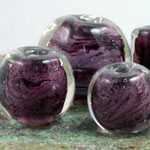
| Rachel uses Thai Orchid to demonstrate the Veining Technique she developed. Check out her tutorial. |
Check out this colorful murrini tutorial with Thai Orchid by Lori Peterson and Kim Milan in the October 2013 issue of the Soda Lime Times. |
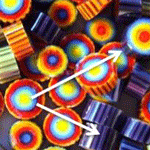
|

| Check out Hannah Rosner’s Bellflower Cascade Pendant tutorial using Thai Orchid in the June 2013 issue of the Soda Lime Times. |
"It's a lovely [slightly reactive in an oxygen rich flame] lavender, lilac and pale violet selection. The glass I have used here includes Lauscha Violet, ASK petal Pink and CiM Thai Orchid." Read more at Kitzbitz Art Glass' blog. |
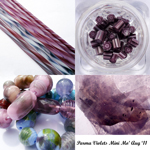
|
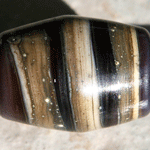
| "I wanted to see the two purples side by side and their interactions with SIS. The lighter side of the bead is Evil Queen and the darker side is Thai Orchid. I think I could get some nice effects with either combo." See more Thai Orchid beads at Chris's blog. |
"Without a layer of encasing, this color doesn't do much for me. Like most other violets, the shade is just too browned out. But layer it with a transparent light purple or even clear and the brownish hue magically disappears, and you're left with a velvety deep violet." Read more at Kandice's blog. |
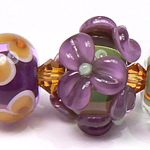
|
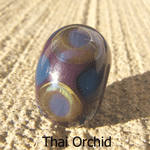
| "I can reduce Thai Orchid without getting the black/gray soot that I sometimes get with Violet and Silver Plum, and the Thai often takes on a luster as if reacting to the reduction or fumes from the silvered glasses. Note the glittery luster on the Thai surface of the bead vs. the dirtier surface of the Silver Plum."
–
Bonnie Polinski
|
"And this is the Thai Orchid, it is a more violet colour, and reminds me of the Moretti Dark Violet. It has a slightly metallic sheen, which may have developed as a result of my accidently double-annealing it." Read more at DragonJools blog. |
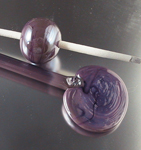
|
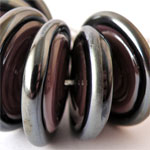
| "Thai Orchid and Dark Silver Plum Discs – made with a base of Thai Orchid [still one of my favorite opaque purples], and Moretti DSP around the rim for a hint of metallic." Read more at Two Glassy Ladies' blog. |
"Dark ivory, Thai Orchid, Bordello frit, silvered ivory stringer, and dark purple. The Bordello frit seems to react on the Thai Orchid." See more of Amy's beads made with Thai Orchid. |
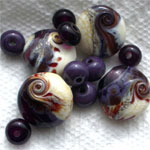
|
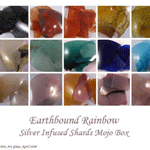
| One-third of this Mojo Box is CiM, including silver infused Thai Orchid shards. View more of Jolene's work.
–
Jolene Wolfe
|